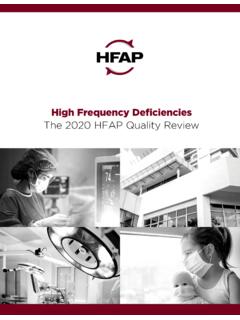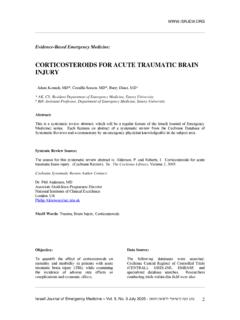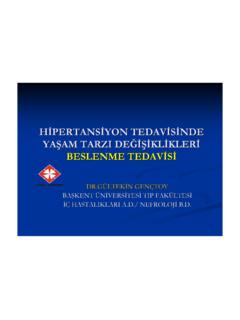Transcription of Improving the Discharge Process - HFAP
1 Improving the Discharge ProcessJerome A. Dixon, , MNS, CCD, FACOFPJune 10, 2010 Objectives Identify problems with current hospital discharges Discuss the impact of unanticipated readmissions on the healthcare system & patient Identify common errors which occur during the Discharge Process Discuss new HFAP standards Discuss key steps/strategies to Improving the Discharge processA Failure to CommunicateAt Discharge : 37% of patients able to state the purpose of all their medications 14% knew their medication s common side effects 42% able to state their diagnosisMakaryus, Amgad N., et al. (2005). Mayo Clinic Proceedings. Patients Understanding of Their Treatment Plans & Diagnosis At Discharge . Aug., 80 (8):991-994A Failure to CommunicateDischarge Summaries: Not readily available 12% to 34% available at first post- Discharge appointment 51% to 77% available at 4 weeks Lacking key components Hospital course & tx.
2 Missing up to 22% Discharge medications missing up to 40% Completed test results missing 33% - 63% Pending test results missing 65% Follow-up plans missing 43%Kripalani B., et al. (2007). Deficits in communication and information transfer between hospital-based and primary care physicians: implications for patient safety and continuity of care. JAMA. 297(8): of Readmissions CMS Save Money Improve Quality of Care Improve Patient Outcomes Identified Target: Readmissions Nearly 20% of Medicare fee-for-service patients discharged from hospital were readmitted within 30 days 34% were readmitted within 90 days Estimated cost to Medicare program: $ BillionJencks, et al. (2009) Re-hospitalizations among patients in the Medicare fee-for-service program.
3 New England Journal of Medicine. 360:1418-28 Impact of ReadmissionsImpact of ReadmissionsUnplanned re-hospitalizations often signal a failure of the transition Process from the hospital to another source/level of in Continuity Variability in 30-day readmission rate Dependent upon patient s diagnosis Part of the problem stems from continuity of care issues. Dr. Michael Rapp, Director of the Quality Measurement and HealthAssessment Group at CMSE rrors Medication & Testing Study looked at 366 patient discharges with a follow-up primary care appointment scheduled within 2 months 42% of those patients had a medication continuity error 12% had a work-up error 8% had a test follow-up errorMoore, Carlton, et al. (2003). Medical errors related to discontinuity of care from an inpatient to an outpatient setting.
4 Journal of General Internal Medicine. 18 (8) & Adverse Events 19% of patients had post- Discharge adverse events due to errors 33% were preventable 33% were ameliorableForster, Alan J, et al. (2003). The Incidence and Severity of Adverse Events Affecting Patients After Discharge from the Hospital. Annals of Internal Medicine. 138 & Adverse Events 23% of patients had post- Discharge adverse events 28% were preventable 22% were ameliorableForster, Alan J et al. (2004). Adverse Events Among Medical Patients After Discharge from Hospital. CMAJ. 170(3): Consequences Hospital admissions are a source of revenue for hospitals New incentives for reducing readmissions are needed Dr. Rapp, CMS Positive and Negative Quality Reporting Publishing hospital readmission rates Reductions in PaymentImproving the Discharge Procedure & Reducing Hospital Readmissions CMS.
5 Lessons Learned Community recruitment & engagement can take longer than anticipated Community meetings are a catalytic point in the Process Increased time & resources are required to engage outpatient physicians & specialists Each patient should be assigned a coach or team member before dischargeRe-Engineered Discharge (RED) Delineation of roles & responsibilities Patient education throughout hospital stay Seamless information flow Written Discharge plan All info organized & communicated to PCP Patient access to Discharge info in their language Reinforcement of Discharge plan for at-risk patients Discharge Process is: benchmarked, measured & subject to continuous quality improvement programsRED Checklist1. Medication reconciliation2.
6 Reconciled Discharge plan with National Guidelines3. Follow-up appointments4. Outstanding tests5. Post- Discharge services6. Written Discharge plan7. What to do if problem arises8. Patient education9. Assess patient understanding10. Discharge summary to PCP11. Telephone reinforcementAdopted by National Quality Forum as one of 2009 s 34 Safe Practices - Safe Practice # 15 Why Use HFAP RED Standards Improves community image Meets safety standards Endorsed by NQF, IHI, Leapfrog & Others Improve clinical outcomes Decrease readmissions from 20% to 15% Decrease ED use from 24% to 16% Improves PCP follow-upWhy Use HFAP RED Standards Saves money Saved $412 per Medicare enrollee, (in one pilot study) Reduces diversion & creates greater capacity for higher revenue patients Improves market share as preferred provider Improves relationships with PCP Prepares for change in CMS rules regarding readmission reimbursementHFAP StandardsHFAP Standards Measures suggested by Dr.
7 Rapp (CMS): Exchanging quality data routinely Creating a collaborative forum that includes patients and families Identifying the sickest patients & reviewing the way they get care, and Implementing personal health recordsImproving the Discharge Procedure & Reducing Hospital Readmissions Keep the Process simple by developing a hospital-wide Process using: Discharge checklist for outpatient discharges Discharge medication reconciliation forms or print-outs Discharge /Transfer order forms for long-term care and Rehab transfers Transfer order forms for hospital-to-hospital transfersImproving the Discharge Procedure & Reducing Hospital ReadmissionsBarriers to Implementation Unclear responsibilities for all elements of Discharge Process receives low priority Medication plan regularly changed Financial pressure to fill beds ASAPB arriers to Implementation Discharge responsibility delegated to least experienced team members Less than optimal staffing when most discharges occur Late afternoon & eveningKey Steps Develop a policy to improve the Discharge Process Recruit and engage key
8 Stake holders Educate hospital staff & physicians Identify the sickest patients & review ways they get care & improve on the Process Track your result with an ongoing Quality Assessment Performance Improvement (QAPI) programQuestions?For any questions regarding the interpretation / application of the new HFAP Discharge standards, please submit









